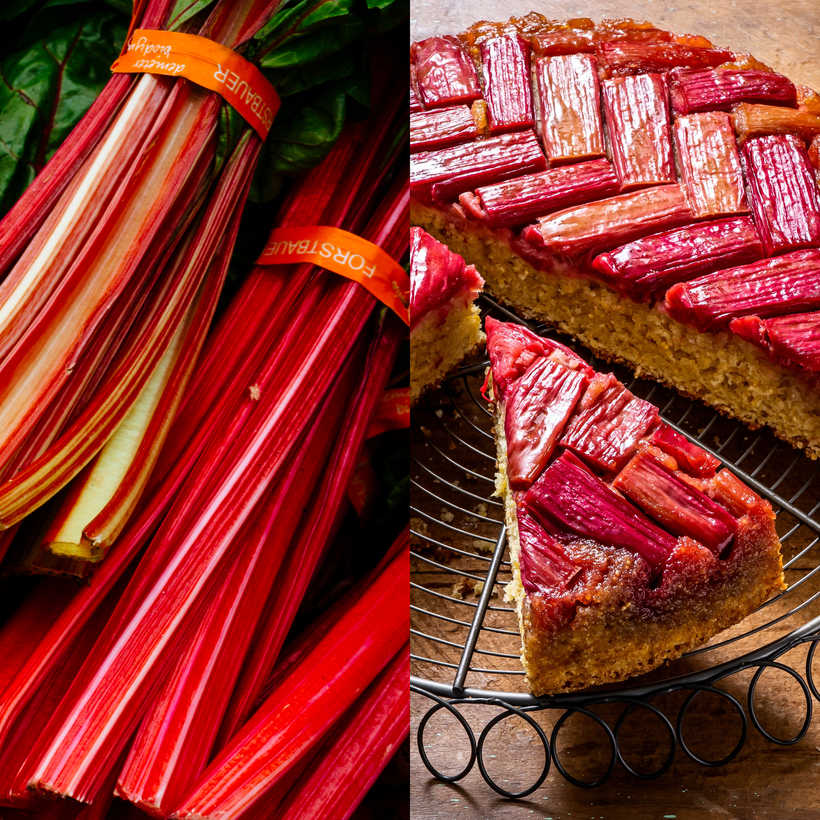London’s sky is “impeccably grey, a denial, really of the very concept of colour,” as Martin Amis wrote in Money. The de-saturation of English life reaches its peak in January and February. But there is one bright foodstuff fighting against the drab: winter-harvested forced rhubarb, a dazzling pink gem of British farming.
The first person to try to wrangle rhubarb into pleasing edibility was certainly an adventurous one. It’s a plant with large, poisonous leaves similar in appearance to chard, while its stalk is texturally akin to extra-stringy celery when eaten raw. However, with plenty of cooking, and plenty of sugar, it can be transformed into a distinctly tart culinary treasure, used in crumbles and sweet pies. It’s one of the few vegetables that has been retrofitted into becoming a de facto fruit.

While ordinary, outdoor-grown rhubarb is harvested during the fruit-rich period spanning April to September, the rarefied, indoor-grown “forced” kind arrives from late December to the end of March. It hails from Yorkshire’s “Rhubarb Triangle”—the area between the industrial cities of Leeds, Wakefield, and Bradford—which became an E.U. Protected Designation of Origin in 2010.
Back in the 1970s, there were around 200 farms cultivating this crop in the area. Now there are only 10, of which R. Tomlinson & Son, a fourth-generation family firm, is considered the Cadillac of the remaining growers.
“Everyone wants Tomlinson rhubarb,” says Bella Tubbs, head pastry chef at the Michelin-starred River Cafe in London. “It’s a dying art, but because it’s growing so much in popularity now I wonder if more and more people will choose to grow it.”
It’s one of the few vegetables that has been retrofitted into becoming a de facto fruit.
The crop is typically planted between September and March and spends two years outside, where exposure to the cold establishes the roots and strengthens the stalks. When the second summer comes to a close, the dormant rhubarb is laboriously transferred into pitch-black “forcing sheds,” which offer heat and water but no light. The plant has just enough sun-derived energy stored from its time in the fields to sustain it through this last stage of maturation.

Here, in total darkness, the rhubarb stops producing chlorophyll, and gains a perfect upright posture as it stretches in search of illumination. The picking, which starts after Christmas, is such a delicate labor of love that it is, remarkably, undertaken by candlelight. Relying solely on the gentle flicker of a candle’s flame ensures that the rhubarb retains a pink stalk that is more sweet and tender than common field-grown rhubarb.
“It’s just the most surreal thing to see in person,” says Tubbs of her recent visit to the farm, where Robert Tomlinson and his wife cut and clean every stalk by hand before sending out the in-demand produce in bright-red boxes.
It’s not just chefs in England who are enthusiastic about it. The high-end food distributor Natoora delivers Tomlinson rhubarb to restaurants around the world, including to Thomas Keller’s three-Michelin-starred Per Se, in New York.

“At the River Cafe we poach the rhubarb to go with our panna cotta, and it’s the most beautiful contrast of colors—that white panna cotta with the bright, candy-like pink rhubarb,” says Tubbs of what has become her favorite seasonal ingredient. “It’s No. 1. Everyone really looks forward to it.”
Forced rhubarb is on the dessert menu only until the middle of March, though, when in-season blood oranges begin replacing it. But the limited availability is part of its attraction.
“It has a season, and then it’s over. That’s kind of what we do at the River Cafe,” says Ruthie Rogers, the founder of the much-beloved institution. “We get excited when a fruit or vegetable arrives, and then we feel sad when it leaves. Everything reflects the seasons.”
Spike Carter is a writer and filmmaker. His next project is a documentary about Eric Roberts


